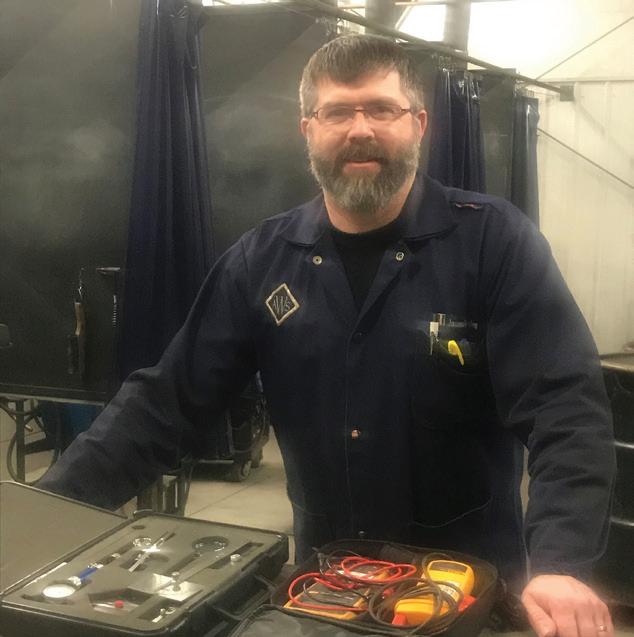
6 minute read
JOINT APPRENTICESHIP PROGRAMS
Joint Apprenticeship Programs Building Excellent Lifetime Careers
By Deb Draper Photos courtesy of Local 219
Kurt Mattson (left) and Luke Baxter (right)
A recent study by the Illinois Economic Policy Institute and the Project for Middle Class Renewal at the University of Illinois at Urbana-Champaign has concluded that joint apprenticeship programs offer viable post-secondary options for good middle-class careers, rivaling bachelor’s degrees in expected lifetime earnings. Using 2018 data, the study found that despite a higher likelihood of unemployment spells, union journeypersons earn about as much on average ($2.4 million) as workers with bachelor’s degrees ($2.5 million after student debt) and more than double the pre-tax earnings of workers from employeronly programs.
As well, apprentices hold the advantage of coming out of years of schooling debt-free with tuition costs carried by employers, labor-management organizations, and unions at no cost to the individual.
Paul Eichhorn, marketing representative/organizer with Local 1 in Peoria, Illinois, sees this as a rare opportunity these days. “It’s a blessing and a financial relief to have a $100,000+ career with no college debt,” he says. “I grew up in the lower middle class on the south side of Peoria, and it was hard to escape poverty. The union trades allowed someone like me to do that, and now I’ve been involved in some capacity in the sheet metal industry for 13 years.”
Like so many young people thinking the answer to a good career is a university degree, Rockford, Illinois Local 219’s fifth-year apprentice Luke Baxter went directly into college out of high school, tried different directions, but after a few years felt he was getting nowhere.
“I didn’t hear anything about the trades in high school, but some family members are union sheet metal workers,” he says. “They told me about the money, how the benefits were really good, and about how apprentices receive five years of schooling paid for. It almost seemed to be too good to be true.”
Baxter says apprentices work hard for their keep, but as he finishes his apprenticeship in sheet metal later in 2020, his wife is also finishing her master’s degree and the difference in the outcome is notable. “I will be making almost double what she’s making coming out of college, while she owes about $50,000 in student loans and I owe nothing,” Baxter says.
“Contractors and unions are coming together for the JATC program. They understand it’s critical for young people to learn the trade correctly and efficiently. This says a lot about the international foundations of SMACNA and the ITI.” — Kurt Mattson, Local 219 JATC board trustee and vice president of DeKalb Mechanical Inc.

Jason Gerdes

Joe Cook, Business Manager at Local 219
In return for their significant investment in the apprenticeship programs, employers receive a highly skilled, productive workforce. Kurt Mattson, trustee on Local 219’s JATC Board and vice president of DeKalb Mechanical Inc., knows that apprentices immediately earning wages and learning on the job is critical from a contractor’s standpoint. “Our scope of work aside, these individuals have thought far enough ahead and determined that this is what they want to do with their lives,” Mattson says. “That kind of commitment tells me they can plan, coordinate, and are responsible.”
He believes the joint apprenticeship program also reflects the commitment of the sheet metal industry. “Contractors and unions are coming together for the JATC program,” he says. “They understand it’s critical for young people to learn the trade correctly and efficiently. This says a lot about the international foundations of SMACNA and the ITI. It’s a great thing for everyone.”
SMACNA Greater Chicago Executive Vice President Tony Adolfs agrees that the programs benefit everyone. “The Locals I work with have very active apprenticeship committees with both labor and management working together,” he says. “A lot of what’s going to happen in the school comes from contractors. They see different things in the field, different technologies. It comes from the union, too. There may be a program that we develop from discussions about a market that our industry could get into. That’s the advantage of having a good working labor-management group.”
This flexibility in training is another strength of joint apprenticeship programs. Jason Gerdes, program director for the ILLOWA Local 91 JATC in Rock Island explains, “The scope of work in our area is a little different in that a lot of our contractors expect apprentices to be able to do a variety of work, so we train them in several directions. Apprentices may be working for a contractor that specializes in a couple of areas and, therefore, gaining expertise while still being exposed to a variety of skills in our training program. This will open up possibilities to work with a broad range of contractors in the future.”
Tyler Pfanz earned his journeyperson’s ticket two years ago through Local 1, but it took him a while to find his calling in the sheet metal industry. “I started out of high school working in a factory,” he says. “I knew college and that sort of structured environment wasn’t for me, but the monotony of the job was burning me out. I had a couple of buddies whose dads worked in the mechanical industry—what they told me piqued my interest, and I decided to pursue something in that direction.”
Pfanz adds that the main draw to the sheet metal industry is the variety—individuals may be working on the tools or as a service technician, but expanding one’s education is simple given there are always instructors on hand or new courses to take that help members of the workforce expand their skillsets.
“The work can be demanding,” he says. “You do a lot of problem-solving, interacting with like-minded people towards a goal, and with other trades on big projects. You have to be willing to work, but the rewards are there.”
Those rewards include excellent healthcare and a pension— both increasingly rare benefits in today’s marketplace.
Joe Cook, business manager at Local 219, believes the joint apprenticeship programs will soon be in great demand as young people realize all that the unions have to offer beyond the good wages and job satisfaction. “When we talk to kids going to college, they aren’t thinking about health insurance or pensions, but those things are becoming a highly-sought commodity these days,” he says.
Local 219 had 100 applicants this year, and the 47% who passed are highly educated college recruits whose parents supported their decision to pursue a skilled trade.
“We’re also seeing college grads who have already spent $60,000 to go to post-secondary school applying for apprenticeships,” Cook says. “They are willing to take a first year apprenticeship job and commit to five years just to be able to pay off their tuition debt and have a good career that they can’t get with a bachelor’s degree.”
From her desk in Calgary Alberta, Deb Smith writes for trade and business publications across North America, specializing in profiles and stories within the hospitality, food service, mining, recreation, and construction industries. When not writing, she’s likely traveling, gardening, or taking long walks with her big white dog.








